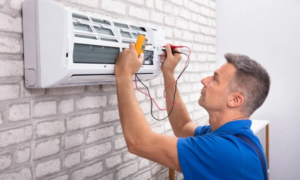
Duct Booster Fans improve the circulation of conditioned air into remote parts of your home.
In the event that you’re having trouble with inconsistent temperature across your house, Duct Booster Fans you’re the only one! HVAC systems may not be able to keep sending cool air to most remote areas of your home. This can lead to areas of cold or hot, as and inconsistent temperatures throughout your home, resulting in the heat wars that are raging.
There’s a good thing that there’s an easy solution for you: An HVAC fan that expands!
While the air duct booster fan could provide your air conditioner with an additional boost, it might not be able to address the root cause of your system. It is therefore recommended to have a professional check your system for any issues such as leaky ducts or clogged air filters or malfunctioning fans. (Kishore Brothers’ AC dealer in Surat offer the most competitive prices on AC & AC Services such as commercial and domestic air conditioning systems, Home Appliances & Water Ionizer machines)
Returning to the topic which is boosters!
What Is a Duct Booster Fans ?
An Duct booster fans is small fan that can be inserted in the air duct. It’s purpose is to boost the airflow to the most remote areas of your home. They can be integrated in the main ductwork trunks but they usually are located in smaller ducts that are specifically designed to only serve one room.
HVAC booster fans make use of its blades in order to bring air cleaned into the room to raise the temperature to ensure that it is more comfortable. Although some ducts are active all day long, others are programmable, allowing you to set the time at which they turn on, which means that they do not have to be on all the entire day. This means that smart or programmable fanducts don’t make your energy bills more expensive and can be a great option for homeowners who want to build more efficient homes without sacrificing comfort.
It may appear to be the perfect solution for your numerous cooling and temperature problems, it’s actually not the right option for your. We’ve mentioned before that air duct boosters can help increase airflow, however they’re not able solve other HVAC problems for example, air leaks in your ductwork, or blocked vents or filters and malfunctioning equipment for HVAC.
Here are some instances where a duct booster may be the right choice in addition to certain situations where it’s not.
When Should You Use a Duct Booster Fans?
If you have issues with irregular heating or cooling in your house, an HVAC booster fan may be the perfect solution to meet your needs. The signs of an imbalanced heating or cooling include temperatures that differ across different areas of your house or uneven temperatures across the different floors in your house or rooms that are crowded.
1.HVAC System Is Too Small for Your Home
A malfunctioning HVAC system may cost a lot to repair. HVAC devices that are too small or large can creates a number of issues. Systems that aren’t big enough or too large are unable to provide adequate heating or cooling, rendering your house uninhabitable in all temperatures.
Finding the best model of air conditioner is crucial however, if the unit isn’t working properly or too big , do not invest thousands of dollars to replace it today. A Duct booster is an affordable solution to improve the airflow of small cooling or heating systems.
-
Uneven Sunlight Distribution
If the rooms in your home aren’t cool enough to face the afternoon sun, an AC booster could be the most economical and efficient choice you can make. Of the course insulation of your house can also help solve the issue. But your HVAC system will be to be the sole source of cooling during the extremely hot and humid days.
As with a window facing to the north, it is most likely to be more cold than other rooms in your house. A duct-based air conditioner could assist in bringing warm air into rooms that are colder , to ensure that it is more comfortable.
-
Rooms Farthest From the HVAC Unit
A majority of houses contain an HVAC unit located at the opposite end of their house. The rooms which are located further of the HVAC unit are not receiving an adequate flow in controlled air. An HVAC booster fan can solve this issue and help improve the circulation of treated air into the rooms.
-
Ducts Are Poorly Designed or Installed
To ensure an even distribution of air throughout your house. The ductwork must be evenly distributed across your home. In the event that all of your ducts are on the opposite side of your home and the rest aren’t getting adequate amounts of cooling. We’ve already mentioned that when ducts are running too long, it could result in less airflow to even the smallest parts of your house.
When Won’t a Duct Booster Work?
Duct boosters are able to address the primary issue of uneven conditions throughout your home. However, they’re not able to solve the root causes of these heating and cooling problems. There are several frequent causes that could result in uneven temperatures throughout your home:
-
Air Leaking From HVAC Ductwork
The ductwork within your home is used to transport clean air of the HVAC unit to the rooms of your house. Any leaks that occur within your ductwork may make it more difficult to effectively transport air. The most frequent causes of air leaks within your ductwork is unfit joints, seams, joints or fixtures as well as the peeling of the tape covering the ductwork connections and ductwork tear and more.
In the event that air leaks led to the formation of cold or hot spots in your ducts and home the installation of a duct-boosting air conditioner isn’t going to fix the problem. Some of the most popular methods for battling air leaks inside the ductwork is to use insulation and duct tape or using liquid sealants.
-
Blocked or Restricted Ductwork
Because your HVAC system is dependent on the ductwork in your home’s ductwork to circulate heated air throughout your home and the ducts must be clear of obstructions. The accumulation of dust or other debris that is too large smaller animal (or rodents) within the ducts, or objects that have a tendency to crush the ductwork could cause obstruction of airflow.
Furthermore, ducts that are flexible might also show bends and kinks in case that they aren’t properly fitted, leading to obstructions within ducts. If you spot this, it is essential to look at your ducts and fix the issue prior to installing an HVAC fan.
Find our tips for cleaning your air ducts here.
-
Damper Misaligned
HVAC dampers comprise of mechanical parts placed at the different branches from which air ducts are branched off within the main trunk. They permit you to take control over the flow of air inside your air ducts and assure that air is distributed to every area within your home.
The dampers can be utilized to stop the airflow to rooms that aren’t being used. However, they could remain in the closed position and limit airflow to certain parts of your home. This is the reason you should ensure that all dampers are opened before you consider purchasing an Air duct booster.
-
Dirty Air Filter
The filthy filters can cause airflow issues in certain places within your home. Along with creating hot and cold spots, dirty filters could cause problems for your HVAC system , causing it to fail and reduce the life span of your HVAC system.
A duct booster fan could result in irregular heating or cooling when the issue is an air filter that is dirty. The only way to fix it is to replace the HVAC filter every 30 to 90 days, based on the type of air filtering that you have.
All of these are issues that can be solved by the HVAC booster fan can’t seem to fix. After you’ve solved these issues and are able to make an informed decision about the need for an AC-duct fans booster. If yes, you’ll need to decide on the kind of booster you’ll require.
Types of HVAC Booster Fans
There are two types of HVAC booster fans, one that is inline-duct-based as well as a register fan.
In-Line Duct Booster Fan
They are also referred to as mid-duct fans. These fans have a cylindrical shape and can be found into the ductwork. They usually serve to replace the section of ductwork. You can pick any spot between HVAC systems as well as any room that has problems with heating or cooling.
Some models are utilized as plug-and-play Duct boosters, they typically require an electrical outlet or hardwiring.
In-line duct fan are generally located near to a vent within the fan unit. This helps to circulate air throughout the system and keeps the heated air from exiting the vents that are closest to it.
Because these duct fans require cutting off sections of your ductwork, you’ll need employ an professional to install them. Engaging an electrician can increase the initial cost of installation, but it’s essential since you’ll need an air conditioner that’s in line with your existing ductwork. After installation the duct booster won’t require any energy.
Register Booster Fan
A different option which is less expensive than the in-line, duct booster could come in the form of an alternative to the Register booster fan, which is sometimes called ” in-the-register” fans. Register fans are devices that plug and play which are easy to set up and operate. Contrary to an in-line boost, this kind of fan can be set in rooms in which more airflow is needed.
Register fans are a replacement for existing ceiling, wall, or floor ceiling registers. They cause a pressure differential to permit greater circulation of air throughout the ventilation. While they’re louder than mid-duct models but they’re the best choice for homes with just three or two rooms are affected by airflow issues.
In-Line or Register Booster Fan: Which Is Better?
The two types of booster fans come with advantages and disadvantages. The decision you choose will be based on the purpose you’re planning to use them , as well as the equipment you have. For example, register fans are great for smaller rooms. They’re a great option for offices in smaller spaces or homes.
In-line boosters for ducts are great for ducting systems for instance, massive commercial structures. Commercial spaces with larger sizes and more complex and intricate ducting systems, a single blower won’t be enough and a number of units are used to increase airflow in any place.
How to Choose the Best Duct Booster Fan?
If you’re convinced that you’re confident that you’re certain that an HVAC booster fan can solve your air conditioning issues What’s next?
You must decide on the air vent booster fan you want to select. Many factors can impact this decision. The most important ones are:
Fan Model
The result of work is similar in the majority of HVAC fan boosters. However, their capacities, dimensions size, and techniques, as well as other aspects differ. Therefore, it is important to know which kind of fans that are duct-based for your requirements and the capacity and size you’ll need. It is also important to determine the budget prior to purchase as you may purchase fans with a variety of options and features to meet different price points.
CFM Capacity
Cubic Feet Per Minute (CFM) is an HVAC gadget which measures the efficiency of a fan through measuring the airflow. It calculates the power of air exchange in an air-flow fan by taking into account the space of the cubic space and the rate of airflow in the room.
In general use one CFM is required for each sq. ft. of floor space. You can calculate CFM yourself also. CFM yourself using this simple formula that considers the ceiling height of the room and area of the room, and the amount that air changes every hour (ACH).
Static Pressure
Simply put The static tension of an air conditioner is the volume of air pressure it is able to generate within the enclosed space. This is a crucial aspect to take into consideration when choosing the most suitable fan for ducts.
To ensure that you’ve made the correct choice, you’ll have to evaluate the static pressure in the area prior to selecting the most efficient model and keeps the static pressure steady within the area. This is done the use of an instrument, but most HVAC booster fans are fitted with the same amount of pressure that is listed on the package. Find the duct booster with a static pressure which is less than 2″.
Loudness Limit
Duct boosters typically produce a lot of sound. However, certain fan models and variations are quieter than other models. For instance In-line duct-boosting fans are generally quieter than registration fan designs. This is why it is important to pick HVAC or duct fans that has the right level of noise.
How Much Can a Duct Booster Fan Cost?
You’re aware that booster fans are an inexpensive solutions to heating and cooling problems within your home. What is the cost you’re expecting to pay for one of these gadgets?
The register-booster fan is an affordable and easy solution. It’s priced between $30 to $80 for each unit. Installation is easy since they’re plug and play however, if you opt to employ a professional to install to put them in place it will cost you 200 dollars more.
In-line register fans are more expensive and register boosters are more expensive. They cost between $30 to $200. The more expensive models feature more sophisticated controls and an electronic display. While the initial cost may appear reasonable, the installation costs associated with these fans can increase by $600 on your amount.
Register fans aren’t as costly than the other two however an in-line duct booster can solve several rooms’ heating and cooling problems. However register fans are only suitable for a single space. This means that you’ll require another registration booster to each space that you’re trying solve heating or cooling issues.
Final Verdict?
A duct booster can assist in resolving the majority of heating and cooling issues. However, if the issue is with the ductwork in your home or HVAC unit the booster won’t necessarily solve the problem. To ensure that you’re making the right decision, consult a professional to determine if the air ducts booster fan is the right solution for you.






